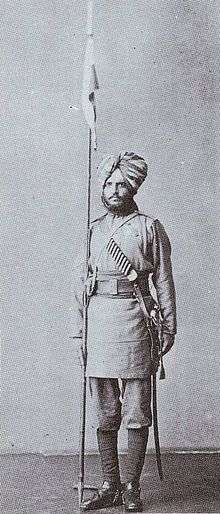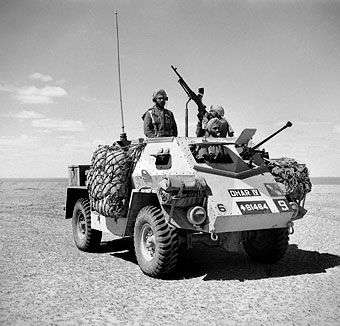Central India Horse
The Central India Horse (21st King George V's Own Horse) was a regular cavalry regiment of the British Indian Army. They were formed at the start of the Indian Rebellion of 1857 and served in the Great War and the Second World War.
| Central India Horse (21st King George V's Own Horse) | |
|---|---|
 A daffadar of the 1st Central India Horse in 1886 | |
| Active | 1857 – present |
| Country | India |
| Allegiance | |
| Branch | |
| Type | Cavalry |
| Size | Regiment |
| Part of | Indian Cavalry Corps |
| Engagements | Indian Rebellion of 1857 Second Afghan War Great War Second World War |
Formation
The regiment was founded as two irregular cavalry regiments in 1857, at the outset of the Indian Rebellion of 1857 by Henry Otway Mayne, and was known initially as Mayne's Horse and the 2nd regiment which was known as Beatson's Horse.
They were based at the town of Guna, in the state of Gwalior and Augar in central India. In 1860 Mayne's Horse was renamed the 1st Regiment Central India Horse, and Beatson's Horse was renamed the 2nd Regiment Central India Horse.
In 1860 the officer commanding the Central India Horse was made the British political officer for the small states of Raghugarh, Khaniadhana (after 1888), Paron, Garha, Umri, and Bhadaura, which were made a separate charge from that of the Resident of Gwalior. This arrangement was abolished in 1896, when these states were again placed under the resident, with the officer commanding at Guna continuing to act as ex-officio assistant to the Resident, with very limited powers. Both Regiments would serve together in the Second Afghan War.
Reorganisation
During the Kitchener reorganisation of the Indian Army of 1903, the 1st Regiment became the 38th Regiment Central India Horse, and the 2nd regiment became the 39th Regiment Central India Horse. In 1906, the regiments were renamed the 38th and 39th Prince of Wales's Own Central India Horse, and in 1910 the 38th and 39th King George's Own Central India Horse.
The Great War
During the Great War the 38th King George's Own Central India Horse was part of the 5th (Mhow) Cavalry Brigade in the 2nd Indian Cavalry Division the brigade consisted of the:
- 6th (Inniskilling) Dragoons
- 2nd Lancers (Gardner's Horse)
- 38th King George's Own Central India Horse
- Signal Troop[1]
Later in 1918 the 38th King George's Own Central India Horse joined the 10th Cavalry Brigade, in the 4th Cavalry Division for the Sinai and Palestine Campaign.
The 39th King George's Own Central India Horse remained in India during the war, stationed in Poona.
Amalgamation
In 1921, the two regiments were amalgamated into the 38th/39th Cavalry, which was renamed the 38th/39th King George's Own Light Cavalry (1922), The Central India Horse (21st King George's Own Horse) (1923), and The Central India Horse (21st King George V's Own Horse) (1937).

Second World War
During the Second World War, the Central India Horse (equipped with Light Tanks and Indian Pattern Carriers) was the divisional reconnaissance regiment for the 4th Indian Division. While attached to the 4th Indian Division they were involved in the Western Desert Campaign, the East African Campaign, the Tunisia Campaign and the Italian Campaign.
It was during the Italian Campaign that two members of the Regiment were posthumously awarded the George Cross: Ditto Ram and St. John Graham Young attached from the Royal Tank Regiment. Notice of the award was published in the London Gazette on 20 July 1945.[2] Young had been leading a night patrol on 23 July 1944, when he and his men found themselves in any enemy minefield. He received the full force of a mine explosion, severely injuring both legs. Despite his wounds, his encouragement enabled the majority of his men to reach safety. One of them, Sowar Ditto Ram, was also posthumously awarded the GC for his actions in the same incident.[3]
Bombay 'mutiny'
In 1940, the Central India Horse was posted to Egypt. While awaiting embarkation the train carrying the regiment was kept in a siding for about twenty-four hours. During this delay four members of a radical political organization – the Kirti Lehar were able to persuade two-thirds of the Sikh squadron of the regiment to refuse overseas service. The remainder of the regiment embarked for North Africa and Italy where it served with distinction. The 'mutineers' were court-martialed.[4]
Cavalry charge at Toungoo
On March 20, 1942 Captain Arthur Sandeman of the Central India Horse was on secondment to the Burma Frontier Force - leading a mounted infantry column. Near Toungoo airfield in central Burma the 60-man mounted patrol mistook Japanese troops for Chinese ones and closed with them before realizing their mistake. Most of the patrol (including Sandeman) were killed in what was probably the last cavalry charge by a force under the command of the British crown.[5][6] Also Hon Capt Ram Bhaj was awarded IOM IDSM during the Second World War.
Independence
Upon India's independence, the Central India Horse (21st King George V's Own Horse) was allocated to India, although a Muslim Punjabi squadron was transferred to the 19th King George V's Own Lancers in exchange for its Jat squadron. When India became a republic in 1950, the regiment was renamed The Central India Horse, which is one of the decorated regiments of the Indian Army. The Central India Horse is now a tank regiment of the Indian Army's XXI Corps (Southern Command).
References
- "The Ypres Salient". Commonwealth War Graves Commission. Archived from the original on 2012-09-14.
- "No. 37185". The London Gazette (Supplement). 17 July 1945. p. 3765.
- "Commonwealth War Graves Commission—Casualty details—Young, St John Graham". Commonwealth War Graves Commission. Retrieved 2008-05-27.
- Mason, Philip. A Matter of Honour. An Account of the Indian Army, its Officers and Men. pp. 513–514. ISBN 0-333-41837-9.
- Luscombe, Stephen; Herlihy, Jim. "Burma Frontier Constabulary: Burma Frontier Force". The British Empire website. Retrieved 7 November 2012.
- F.F.3, Burma Frontier Force